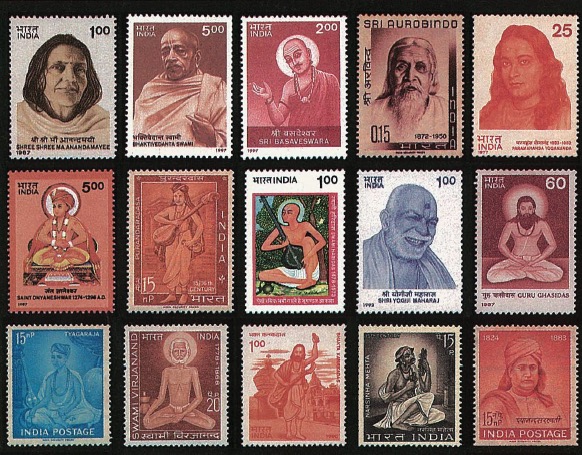(Hard copy of Hinduism Today contains over 60 full color photographs of some of India’s finest Sacred Stamps)
Stamp collecting is an improbable method of theological inquiry–except in India. Nearly every postage stamp initially issued by the newly independent country in 1948 and 1949 had a religious theme, carefully inclusive of Hinduism, Buddhism and Islam. Most stamps issued since the 1950s have a secular theme, but about 100 are Hindu. They honor ancient sages such as Tiruvalluvar and Valmiki and saints from the medieval period, such as Dnyaneshwar, Chaitanya and Haridas. Many stamps carry modern saints, friends and scholars of Hinduism, including Ramakrishna, Swami Sivananda, Annie Besant and Ananda Coomaraswamy. Also included are temples, sacred dances and arts, scenes from the Ramayana and Indus Valley seals. Among the most striking is the double-size, five-rupee stamp issued in 1996 depicting the Vivekananda Rock Memorial at Kanya Kumari. Hinduism Today was introduced to this heretofore unknown goldmine of devotion by Pradip Jain of Bihar State, one of India’s leading philatelists.
Jain started collecting stamps in 1969 with an initial investment of three rupees, soon augmented by a loan of Rs.100 from his grandmother. “I live by stamps,” he told the Hindustan Times in 1994. He has received many awards, especially for his unequaled collection of Indian airmail stamps, and has represented India at various international stamp shows–most recently in San Francisco, California.
What makes the Indian stamps with a religious theme especially useful are the “information sheets” produced by the Department of Posts when a stamp is released. Each contains a short biography or story about the subject of the stamp, often in both Hindi and English. These synopses are very well done; in fact, a collection of them made into a book would form an excellent reference.
Mail service is an old concept–the earliest references are in Egypt from 2000 bce. According to Jain, there was an organized postal system during the Mauryan Dynasty in 300 bce that was mentioned in Kautilya’s Arthashastra, a manual on statecraft. Postage stamps are a relatively recent invention, dating only to 1840. They allowed the sender to prepay the postage; previously, the recipient paid the messenger.
Assembling a collection of dharma stamps need not be expensive. Save for a few rare ones, like the 1948 ten rupee Gandhi stamp worth US$60, most Indian stamps have a list value of US15¢, though lack of availability may raise the price. Every stamp issued by India (and every other country) is listed in the authoritative Scott’s Catalog, available at libraries. Each stamp has a “Scott’s number,” used by dealers to identify it. Especially for children and teens, India’s religious stamps offer an entertaining and educational introduction to Hinduism’s important people and places.
STAMPS OF INDIA CAN BE PURCHASED FROM PRADIP JAIN, POST BOX 128, MITHAPUR, PATNA 800 001 INDIA, OR FROM DOWNTOWN STAMP COMPANY, POST OFFICE BOX 329, WHITEHOUSE, NEW JERSEY 08888 USA
